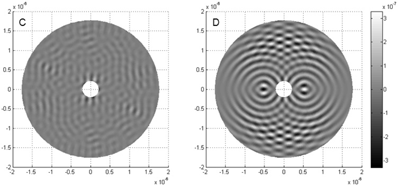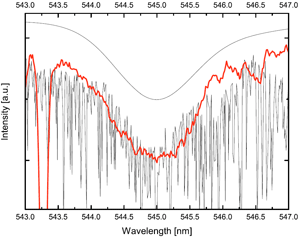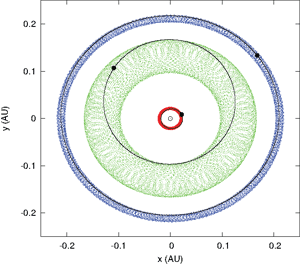|
In section 1. Letters to the Editor
“Strong starlight suppression sufficient to enable direct detection of exoplanets in the habitable zone”, by S.R. Martin, and A.J. Booth, A&A 511, L1
Detecting photons from planets in the habitable zone of nearby stars
is challenging, due to the much larger flux and close angular
proximity of the star. The authors demonstrate in a laboratory setting
that an interferometric nuller, with the rejection level expected on
a spacecraft interferometer, can suppress starlight to the level
needed to obtain mid-infrared spectra of exo-Earths at 1 AU from their
star.
|

|
|
In section 1. Letters to the Editor
“A coincidence between a hydrocarbon plasma absorption spectrum and the lambda 5450 DIB”, by H. Linnartz, N. Wehres, H. Van Winckel, G.A.H. Walker, D.A. Bohlender, A.G.G.M Tielens, T. Motylewski, and J.P. Maier, A&A 511, L3
Linnartz et al. present cavity ring-down measurements that reveal a vibronic band that gives an excellent match to the broad diffuse interstellar band at 545nm. This is the first unambiguous match of a laboratory spectrum with a broad DIB. Unfortunately, the exact form of the laboratory 545nm carrier could not be identified.
|

|
|
In section 10. Planets and planetary systems
“The HARPS search for southern extra-solar planets. XIX. Characterization and dynamics of the GJ876 planetary system”, by A.C.M. Correia, j. Couetdic, J.Laskar, X.Bonfils, M. Mayor, J-l. Bertaux, F. Bouchy, X. Delfosse, T.forveille, C.Lovis, F.Pepe, C.Perrier, D. Queloz, and S. Udry, A&A 511, A21
GJ 876, also known as IL Aqr, is only 4.72 pc away from our Sun and is the closest star known to harbor a multi planet system: 2 Jupiter-mass planets on 61 and 30 days period and a low-mass inner planet with a 1.9 day orbital period. With detailed modeling of 4 years of HARPS radial velocity data combined with 8 years of Keck data, Correia et al. are able to constrain the orbital inclinations of the two giant planets (48.9? ± 1.0? and 48.1? ± 2.1? compared to the line of sight). This is the first time that the inclination of a non-transiting planetary system is determined. This allows giving the true masses of the planets, Mb = 2.64 MJup and Mc = 0.83 MJup. That these resonant eccentric planets share the same orbital plane indicates that their capture into resonance came from slow migration rather than scattering, and is thus crucial for assessing the early orbital evolution of planetary systems. Correia et al. also confirm the existence of the inner planet and provide a more accurate estimate of its minimum mass, 6.3 Earth masses.
|

|




